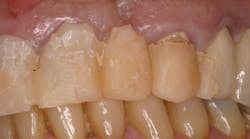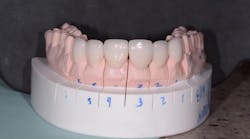Computers help dental implants look natural
Dental problems can make an individual self-conscious about his or her appearance. A person’s face is nearly always visible, and the teeth are among the first things people notice when someone speaks or smiles. Dental Implant Surgeons work to ensure not only that dental implants are functional, but also that they look natural.
An article in the current issue of the Journal of Oral Implantology describes a simple method to recreate what is known as the mouth’s “emergence profile” with dental implants. It presents step-by-step procedures that the authors used successfully in the clinic and laboratory for 50 implants.
ADDITIONAL READING |Bone regeneration through tissue engineering offers new prospects for oral procedures
The emergence profile is essentially the shape of the teeth, from where they leave the soft tissue of the gums and emerge or transform into crowns. In recreating the anatomy of teeth with implants, an emergence profile with a natural shape looks best; it also reduces the chances of trapping food and/or plaque. As noted in the article, “The ultimate goal of a dental implant is to restore missing teeth by placing implants that are anatomically correct and esthetically pleasing in functional positions that ensure long-term durability.”
The current study looks at 50 cases of implants with custom abutments made of titanium and zirconia, two commonly used materials. Abutments connect the replacement tooth to the body of the implant. Customizing their design allows surgeons to create a more natural tooth-emergence profile for each patient.
ADDITIONAL READING | A comparison of graft techniques for the alveolar ridge prior to oral implant
Using computer-aided design and machining technology, the authors were hugely successful in creating healthy implants that had natural and esthetically pleasing appearances. The simple computerized technique provided a precise fit, and it was less expensive and had better accuracy than conventional techniques. To replicate their success, they noted that the process should be well planned before surgery and the implants should be placed accurately. In addition, the surgeon needs to be careful when working with the soft tissue in the patient’s mouth and insert temporary crowns properly.
In the 50 reported cases, there were no complaints of pain from the patients and no infections related to the implants. All implants were in place and had healed well one year later, with no signs of irritation or inflammation. All patients were satisfied with how the implants looked.
The authors concluded that with the help of computers, dental implants can become more esthetically pleasing than they might be using conventional techniques. Although each patient has a unique emergence profile that should play a role in that individual’s expectations, computer-aided technology was found to produce the best results.
Full text of the article “Esthetic Considerations for Reconstructing Implant Emergence Profile Using Titanium and Zirconia Custom Implant Abutments: Fifty Case Series Report,” is available in the October issue of the Journal of Oral Implantology.
For more information about Journal of Oral Implantology, visit their website.

